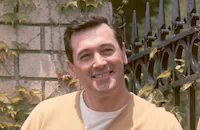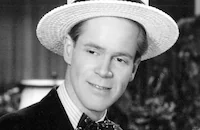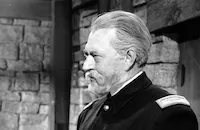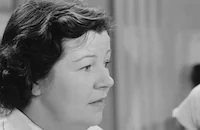Battle Hymn

Brief Synopsis
Cast & Crew
Douglas Sirk
Rock Hudson
Anna Kashfi
Dan Duryea
Don Defore
Martha Hyer
Film Details
Technical Specs

Synopsis
In 1950 in Westhampton, Ohio, Reverend Dean Hess feels that he is continually failing to inspire his congregation. After one service, he admits to his wife Mary that he cannot get past the guilt he feels from World War II, recalling the incident that haunts him: Dean is a colonel in the Air Force and is nicknamed "Killer" for his perfect flight bombing record. One day, however, his bomb does not detach on time and hits a German church that his mother used to attend, killing thirty-seven children in the neighboring orphanage. In the present, Dean decides he must apply to be recalled into service for the Korean War, and although Mary fears this will only worsen his remorse, he is quickly accepted to lead a squadron in training Korean pilots to fly bombers. In Seoul, General Timberidge gives Dean his orders to take control of the slipshod training unit currently camping at an abandoned airfield, and warns him never to risk their few planes by entering into a combat situation. Dean arrives days before the Korean officers and immediately shapes up the slovenly company, which includes his World War II buddy, Capt. Dan Skidmore. When their work clearing the airfield is slowed by a lack of tools, Dean takes his right-hand man, Sgt. Herman, into the closest town. There, although almost everything has been destroyed by bombers, an English-speaking young woman, En Soon Yang, directs them to an antique road-scraper. With the new machine, the airstrip is quickly finished, just in time for the arrival of Major Chang and his eager officers. Over the next weeks, training goes smoothly, and when Major Moore spots enemy planes close by, the pacifist Dean reluctantly allows the planes to carry ammunition as a protective measure. Thanksgiving arrives, and while the men enjoy a feast, local orphans sneak into camp and raid the garbage cans for scraps. As soon as Dean sees the mess sergeant chasing the kids away, he orders that any refugee will be fed, and soon the camp is overrun with hungry orphans. One day, while leading a few planes in training, Skidmore is asked by a nearby Army troop to take out approaching enemy tanks. Against orders, he and Lt. Maples attack the line of tanks, but Maples is devastated after he mistakenly strafes a truckload of nurses and babies. Dean discovers the attack and grounds Skidmore, who accuses his old friend of becoming too soft for war. Dean visits Maples to console him, but instead finds comfort in the lieutenant's conviction that every action is part of God's invisible plan. Soon after, Chang discovers that one of the refugees is a spy, and Dean realizes he cannot allow civilians in the camp. He loads the kids into a jeep and, on the way to town, spots a ruined Buddhist temple. Inside are En Soon and a few sick children, and Dean quickly convinces her that, with his help, they can transform the temple into a safe haven for the orphans. En Soon agrees to stay and is soon joined by an old Korean man, Lu Ahn, who carves Christian religious figures in ivory. Dean commissions Maples to help with the kids, and sends Herman in search of candy, which the wily sergeant finagles from a nearby Navy supply station. When he opens a cartload of chewing gum, one young orphan, Chu, quickly swallows the whole pack. With the cooperation of the whole Air Force camp, the temple is soon made livable, and almost 400 children fill the rooms. One night, En Soon reminisces to Dean about her home in Cheju-Do, a neutral island where she and the kids could be safe. Later, mail arrives at the camp, and after Skidmore spots a letter addressed to "Reverend Dean Hess," he worries that his commander will not be able to lead them in combat if there is an emergency. The letter reveals that Mary is pregnant and an overjoyed Dean races to headquarters, where he manages to tell Mary how much he loves her before the phone connection is cut. Only En Soon, who did not know Dean was married, is saddened by the news, but graciously offers him a pine branch, the Korean symbol of eternity. A few weeks later, the Chinese ambush the area, and Dean is forced to lead his company in a counter-attack. When Maples is almost killed by an enemy gunner, Dean fights his conscience and takes out the Chinese plane. Later, his guilt is assuaged by Lu Ahn, who counsels Dean to let God judge the cause, not the action. That night, another squadron of enemy tanks approaches, but it is raining so heavily that the airstrip is packed with mud. Dean bravely volunteers to make the trip, and Skidmore, regretting ever doubting his friend, insists on joining him. The two make a heroic liftoff and successfully attack the tank line, but a cocky Skidmore is shot. Dean talks his buddy into hanging on through the flight home, but Skidmore is mortally wounded, and in the sick bay, asks Dean to help ease his fear of death. Feeling truly inspired for the first time, Dean describes death as a door from darkness into light, and as Skidmore slips away, he thanks his newfound spiritual guide. Soon, Dean receives new orders, and when he visits En Soon to say goodbye, Chu, who has come to love Dean like a father, cries upon learning that he is leaving. Dean arrives at headquarters, but as soon as he hears that his old airfield is about to be attacked, he jumps into a jeep and returns to the orphanage, where Herman and Maples are trying to evacuate the kids. With no planes available, the whole group begins a slow walk toward safety. Ten miles to the nearest airstrip, Dean rushes ahead in the jeep, only to find that the last plane has just left. As he races to a nearby Naval port, a sergeant at the airstrip calls General Timberidge to inform him of Dean's whereabouts. At the port, there are no ships available for civilian use, and a discouraged Dean returns to help En Soon gather the children at the old airfield. There, Chinese planes strike, and En Soon is killed protecting a young girl. Anguished, Dean holds a small funeral and places a fir branch on top of her grave. Suddenly, five transport planes, big enough to fit all the children, appear in the sky, courtesy of General Timberidge. Months later, Dean brings Mary to the new Orphans Home of Korea, in Cheju-Do, and reads to her the plaque in front of the building: "Dedicated to En Soon Yang, 1950."

Director

Douglas Sirk
Cast

Rock Hudson
Anna Kashfi

Dan Duryea

Don Defore

Martha Hyer
Jock Mahoney

Alan Hale [jr.]

James Edwards

Carl Benton Reid

Richard Loo
Philip Ahn
Bartlett Robinson
Simon Scott
Teru Shimada
Carleton Young
Jung 'kyoo Pyo
Art Millan
William Hudson
Paul Sorenson
Phil Harvey
Warren Hsieh
James Hong
Ralph Ahn
Stanley Cha
May Lee
Kenneth Osmond
Reg Parson
Amzie Strickland
Steve Pendleton

Kenneth Macdonald
Robert Brubaker
Fred Nurney
Glen Denning
Steven Hayes
Ashley Cowan
Kay Stewart
Frank Chase
Steve Wayne
Warren Lee

Margaret Bert
Angelia De Witt
George Blagoi
On Soon Whang
Daiwon Lee
General Earle E. Partridge
Paul Levitt
Alan De Witt
John Truax
George Hickman
Ron Brown
H. W. Gim
Crew
Leslie I. Carey
Norman Deming
Oliver Emert
Vincent B. Evans
William Fritzsche
Russell A. Gausman
Joseph Gershenson
Alexander Golitzen
Charles Grayson
Marshall Green
Colonel Dean Hess
Ross Hunter
Corson Jowett
Gilbert Kurland
Russell Metty
Terry Nelson
Emrich Nicholson
Russell F. Schoengarth
John Sherwood
Frank Skinner
Joan St. Oegger
Clifford Stine
Bill Thomas
Bud Westmore

Film Details
Technical Specs

Articles
Battle Hymn
The screenplay by Charles Grayson and Vincent B. Evans makes Hess seem a cross between Sergeant York and Oskar Schindler. Wracked with guilt over his accidental bombing of a German orphanage, Col. Hess is troubled by air support missions in Korea that put civilians at risk. At first helping a Korean woman (Anna Kashfi) take care of a few orphans, he establishes a large care center, and then makes a monumental effort to safeguard the children from the communist onslaught. Director Sirk broke his leg on location early in the picture, and complained that he had to deal with Col. Hess, who was on the set supervising at all times. The Colonel was pleased to see himself portrayed by the glamorous Rock Hudson, but Sirk felt the star was unsuited for the contradictory role of a devout flying parson, whose combat nickname was, 'Killer.' With American airmen portrayed as paternal babysitters, the real-life effort to save the orphans comes off as an attempt to put a happy face on a miserable war.
Hudson's Hess finds spiritual optimism in almost every scene, as when he assures a dying comrade (Don DeFore) that he is taking "a wonderful step from darkness to light." Adding racial discomfort to the film's arguments, Hess counsels gospel-singing Lt. Maples (James Edwards) after the black flier accidentally strafes a column of civilian refugees. Anna Kashfi's character falls in love with Hess, only to discover that he has a wife back home (Martha Hyer). The New York Times' Bosley Crowther was quick to note that mixed-race relationships still end badly for the non-white love interest. Perhaps discouraged by the wall of sanctimony around the real Col. Hess, historical critics waited over forty years to charge that he falsified his role in the evacuation of the orphans. Yet it is reported that Hess used his Hollywood fees to fund more charity work in South Korea. Filmed in CinemaScope and Technicolor, Battle Hymn is still remembered for its impressive aerial combat scenes featuring shiny P-51 Mustang aircraft. The Korean pictograms on Hess's plane read, "By Faith I Fly." Director Sirk would film another remake of a John M. Stahl weepie, Interlude (1957), and then return with Rock Hudson and even more impressive aviation thrills in The Tarnished Angels (1957).
By Glenn Erickson

Battle Hymn
Quotes
Trivia
Notes
The working title of this film was By Faith I Fly. The opening credits include the statement: "Our appreciation to the Department of Defense, United States Air Force, United States Army, Texas Air National Guard, Arizona National Guard." The closing credits contain the following written statements: "Dedicated to those we could not save."-Dean E. Hess, Colonel, U.S.A.F.; and "The children from The Orphan's Home of Korea portrayed themselves in this motion picture." The film begins with an onscreen appearance by General Earle E. Partridge, Commander of the 5th Air Force in the Korean War, who states that Hess's courage and sacrifice affirms the central goodness of the human spirit. Partridge is portrayed in the picture as "General Timberidge," played by Bartlett Robertson.
As depicted in the film, Col. Dean E. Hess fought in World War II and then, after becoming ordained as a minister, returned to combat during the Korean War. There, he provided food and shelter to hundreds of Korean orphans. In 1950, as the Chinese Communist troops overtook Seoul, Hess persuaded his superiors to facilitate "Operation Kiddy Car," an airlift of hundreds of children to the sanctuary of Cheju-Do, an island off Korea's southern coast. According to modern sources, by the time Hess left Korea, the orphanage housed over 1,000 children. Hess later created Hope, Inc., a non-profit organization that raised funds for the orphanage, and donated to them all of the profits he earned from selling the rights to his autobiography, By Faith I Fly, to Universal.
According to an August 1955 "Rambling Reporter" column in Hollywood Reporter, Universal considered Montgomery Clift to play "Dean Hess," while a November 1955 "Rambling Reporter" item named Van Johnson as a possible star. According to a February 1956 Hollywood Reporter item, Keenan Wynn was considered to play "Sergeant Herman." Although a November 1955 Hollywood Reporter new item stated that Hess would play himself in the film, studio press materials indicate that he served as the technical director, flying airplanes in combat scenes and keeping command over all operational aircraft on loan from the Texas Air National Guard and the United States Air Force.
The film was shot on location in Seoul, Korea and Nogales, AZ. New items and studio press materials reported that after director Douglas Sirk broke his ankle while shooting a scene in March 1956, assistant directors John Sherwood and Marshall Green shot some of the Arizona footage. By May 1956, according to a New York Times item, Sirk was back on the set, working from a wheelchair.
According to Universal press materials, twenty-five children from Hess's orphanage, The Orphan's Home of Korea, and their director, On Soon Whang, played roles in Battle Hymn. The press materials state that although over 100 requests were made to adopt the children, the regulations governing their visit to America disallowed adoptions. A February 1957 Life article, however, detailed the adoption of Jung 'Kyoo Pyo, who played "Chu" in the film, by American couple Harold and Terry Friar. Phil Harvey made his feature-film debut in Battle Hymn.

Miscellaneous Notes
1956 Golden Globe Winner for Best Film Promoting International Understanding.
Released in United States on Video May 14, 1996
Released in United States Spring March 1957
The film is introduced by General Earle Partridge, commander of the 5th Air Force during the Korean War.
Began shooting March 1956.
Completed shooting May 1956.
CinemaScope
Previewed in Los Angeles December 1956.
Released in United States on Video May 14, 1996
Released in United States Spring March 1957














